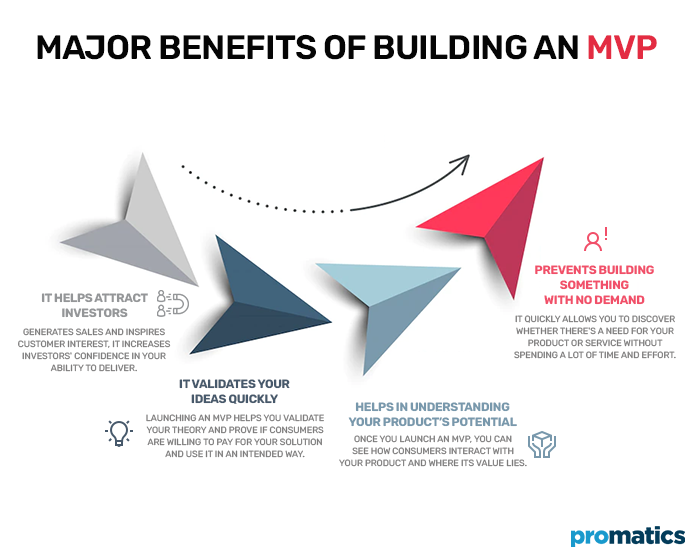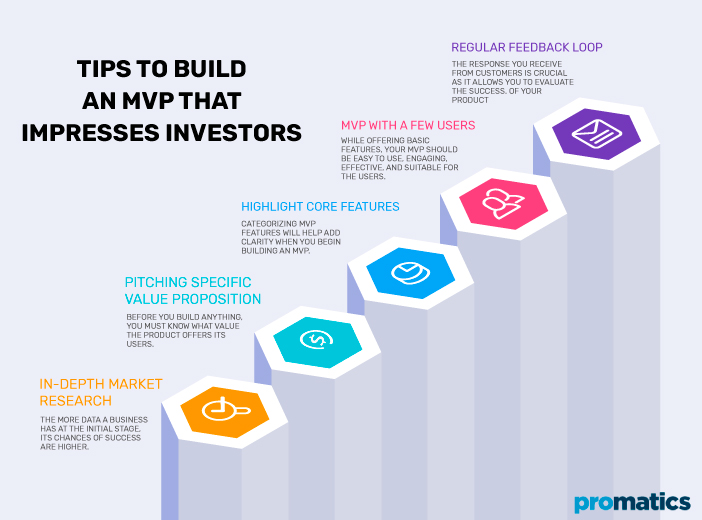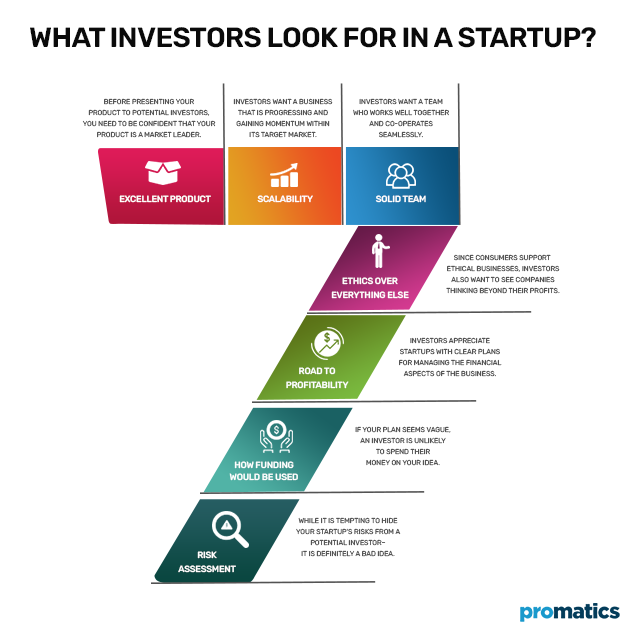How To Build An MVP That Can Attract Investors?
Having a brilliant business idea is exciting but pitching the same to investors is an intimidating thought. Startups usually require external funding to realize their full potential and need to pull investors and get them on board with their business proposition.
While it may sound pretty straightforward at first, modern investors aren’t quick at jumping on the bandwagon when it comes to new ventures. Therefore, the responsibility of convincing investors lies with the business owner, and the best way to achieve this is by building an MVP that is hard to ignore.
About 90% of startups fail to achieve their financial goal, whereas 10% of startups fail within the first year. One of the top reasons 9 out of 10 businesses are unable to sustain is a lack of cash or failure to raise new capital. Another factor contributing to these statistics is misreading market demand for the product or service.
An MVP is an ideal solution for businesses launching new products or services. By designing and building an MVP, they can test their concept with real users and raise money to fund further development.
What is an MVP?
We have repeatedly mentioned MVP in the article, but what does it mean exactly?
Minimum viable product or MVP is a concept taken from the Lean Startup Methodology. It refers to a basic version of the product that supports must-have features that define its value proposition. It helps businesses get users’ feedback as quickly as possible and enables them to validate the product idea early in the product development life cycle.
It all started in 1999 when a young man came up with the idea to sell shoes online. He was curious if people would be interested in buying from him, so he decided to test out the concept. With an essential website up and running, he went to the shoe store, clicked a few pictures of shoes, and posted them on his site.
Upon receiving an order, he went back to the store to purchase it and shipped them out. While he could not make a profit on either sale, he discovered an ingenious way to test a business idea. After establishing that people were indeed interested in buying shoes online, he turned the concept into a fully functional business. This is the story of Nick Swinmurn, the owner of Zappos– the company which was later acquired for $1.2 billion by Amazon.
What Are The Benefits Of An MVP?
When a business plans to launch a new product or service, it attempts to validate its hypothesis on the target market.
Thus, Patrick Collison’s remark seems more than accurate, “You are trying to figure out in the early days of starting a product; are we wrong or is the world wrong?”
The purpose of an MVP is to test your idea with the smallest amount of money, time, and features, hence the word minimum. It allows you to identify the right audience, pull ideas based on experience, and save time.
Here are a few prominent benefits of building an MVP before you venture into the market with a new product.
a.) Prevents Building Something With No Demand
When you build a product or service, you create it with the aim of users benefiting from it. They can only take advantage of your offering if they need it in the first place.
Let’s assume you developed an app that helps people count the number of minutes they talk in a day. You spent a month building the app from the ground up and spent a considerable amount designing and developing it.
When you finally handed over the product to the end user, you realized that no one needs such an application in their daily life. This is what a minimum viable product saves you from.
It quickly allows you to discover whether there’s a need for your product or service without spending a lot of time and effort. The key is to build a basic product that enables you to understand customers’ behavior and analyze if they are willing to pay for what you have to offer.
b.) Helps In Understanding Your Product’s Potential
Bumble was launched as a dating app, but the creators soon realized that users favored the platform for networking. This observation let the team pivot and develop Bumble Bizz, a platform that helped connect professionals.
Once you launch an MVP, you can see how consumers interact with your product and where its value lies. The feedback from users helps you understand your product’s true potential and whether you should continue development in the same direction or reassess your route.
c.) It Validates Your Ideas Quickly
Before you begin working on a product, you already have a hypothesis in your mind. Launching an MVP helps you validate your theory and prove if consumers are willing to pay for your solution and use it in an intended way. In case things go differently than planned, you can quickly pivot your business strategy and save yourself from wasting funds and time on an idea that doesn’t impress users.
d.) It Helps Attract Investors
There needs to be more than just having a business idea to attract external funding. Investors want a startup with a viable product that solves a problem before they invest in it. An MVP shows them that you are not just conceptualizing your idea but have established a base product.
Investors are likelier to put their money into startups they believe will bring in the big bucks. When you already have an MVP in the market that generates sales and inspires customer interest, it increases investors’ confidence in your ability to deliver.
An MVP plays an integral role in getting your business off the ground– it provides you the throttle you need to push your business forward while the funding acts as fuel.
How To Build An MVP That Impresses Investors?
American entrepreneur Reid Hoffman once said that if a business owner is not embarrassed by their first product, they probably launched it too late. Unfortunately, many startups focus more on the ‘minimum’ part than the viability clause when testing a new product.
For example, some experimenters launch a free sub-domain website that has practically no content and name it a startup. When that so-called MVP cannot attract users, they call it a failed MVP and start looking for other solutions.
Before you build an MVP, it is important to understand what you aim to achieve through it. An MVP should be created following proper steps and procedures to ensure desired results.
Here are the steps that are crucial for MVP development.
Step 1- Market Research
No matter how brilliant your business idea is, it is unlikely to succeed if it doesn’t fit market needs. Before a business develops an MVP, it should ensure that it fulfills target users’ needs.
The first step is to gather information through market needs and trends, consumer needs and expectations, competitors’ offerings, and so on. The more data a business has at the initial stage, its chances of success are higher.
As many startups fail due to a lack of market research, it only makes sense to focus on it as your first step. The idea is simple: If your product doesn’t solve a problem, customers wouldn’t be interested in buying it as a solution.
Step 2- Determine Your Product’s Value Proposition
Before you build anything, you must know what value the product offers its users. How does it benefit them if they buy it? Is it different from other products available in the market? If yes, what is the right way to highlight the differentiation? Questions like these will help outline the product’s value proposition.
This step is interlinked with the previous one because you need to know what problem it solves to understand how it can add value. As a minimum viable product, it should be able to deliver on its promise in its most basic state.
Start by identifying the target users and build the MVP based on their needs.
Step 3- Outline the Key Features Of Your Product
Once you have a better understanding of your target market, its needs, and how your product aims to address them, you can move on to outlining the key features of your product. This is where you identify exactly how you will solve the problem, or the core MVP features your product or service will offer.
Since it is a minimum viable product, you must stick to the basics and stay moderate with features and functionality. Instead, focus on the essential components that will effectively address the needs of your users.
You can categorize MVP features based on high priority, medium priority, and low priority, and you can arrange these features in the product backlog. This will help add clarity when you begin building an MVP.
Step 4- Build and Launch the MVP
After you have finalized the features you need to include, it’s time to build and launch your MVP. Remember, a minimum viable product doesn’t infer low quality or poor user experience.
In fact, this is the stage where you want to attract consumers and convince them to buy your product; hence, you must focus on creating an excellent user experience. While offering basic features, your MVP should be easy to use, engaging, effective, and suitable for the users.
Step 5- Analyze Customer Feedback
Once you have launched your MVP, get user feedback and analyze it to understand your market position. The response you receive from customers is crucial as it allows you to evaluate the success of your product, what features add value and which ones you should remove, and how you can improve your product to satisfy your customers.
i.) Customer feedback is the culmination of the MVP development process.
ii.) It proves whether your market research was accurate and adequate
iii.) It shows if there was a need for your product
iv.) It validates whether your product offered an effective solution to customers’ problems.
v.) It shows if users are willing to pay for your product’s basic features
vi.) It gives you direction as to whether you should continue or pivot your business strategy
Mistakes To Avoid When Building An MVP
The MVP development process enables startups to test their product’s value without dedicating much time and effort. However, to create a successful MVP, you should avoid some developmental mistakes that might lead to a business failure.
Choosing The Wrong Problem To Solve
Every product or service can be successful if it solves the customers’ pain points. However, before spending months developing a product, it’s essential to determine if the product is worth creating or not. A startup should be able to answer the following questions:
- Who is the product for?
- What problem does it solve?
- Is your proposed idea an effective solution to that problem?
If you are targeting everyone with your product or service, you will end up serving no one. Therefore, a business should choose its target audience smartly and select a problem that customers would actually be interested in solving.
Ignoring the Prototype Phase
Once you have conceptualized your business idea, it is crucial to translate it into a fully working product or service. Imagine building a motorcycle without referring to a visual model– jumping to the development process without defining the requirements can cause trouble with the final product.
Creating the prototype means focusing on ‘how’ your product solves the pain point. You can think of it as an MVP to build an MVP. Although it is a partially functional version, it still helps picture the user experience of the minimum viable product.
Targeting the Wrong Segment for Feedback
User feedback is crucial for an MVP to be successful because they are the ones who can tell you what’s good in your product and what needs improvement. For this reason, choosing the correct segment of the audience for feedback is necessary.
If you cannot acquire comments and feedback from the target audience, you could make changes to the product/ service that do not add to its value proposition. Only involve your friends or relatives in this stage if they are your target users. Focus on potential users who will eventually benefit from the product.
What Do Investors Want in a Startup?
Here are a few basic points an investor will consider before siding with your startup business:
An excellent product or service
This goes without saying, but we will still say it. If your product or service is not a winner, investors will not spend the time of their day considering it. Before presenting your product to potential investors, you need to be confident that your product is a market leader. As a startup, you will face a lot of competition from other established and new brands– your responsibility is to rise above it and show what sets you apart.
Scalability
When investors analyze a new product or service, they prefer something scalable with opportunities for growth and expansion. They want to see proof that your product can grow over time and that you have plans to facilitate it. Investors want a business that is progressing and gaining momentum within its target market.
A dedicated founding team
Investors don’t just invest in a business but the team behind it. They must know they are pledging their resources to a knowledgeable, driven, and expert team with a passion for being successful. They want a team who works well together and co-operates seamlessly.
An ethically responsible business
Nowadays, having a great product isn’t enough. Investors want businesses to have strong links with the community and a genuine intention of positively impacting the environment. Since consumers support ‘ethical’ businesses, investors also want to see companies thinking beyond their profits.
Solid financial plans
Investors appreciate startups with clear plans for managing the financial aspects of the business. Businesses with a good financial grip can easily forecast cash flow, balances, turnover, and profit. An investor prefers startups that are upfront about their figures and any potential risks.
Clear plans about using investor’s money
Once you have decided on the amount you want from an investor, you need to work out how and where you will spend that money. If your plan seems vague, an investor is unlikely to spend their money on your idea. On the other hand, having a clear goal helps investors understand when they will get a return on their investment and what contribution is expected from their end.
Accurate risk assessment
While it is tempting to hide your startup’s risks from a potential investor– it is definitely a bad idea. Investors usually look for risks before investing in a venture, so if you hide something rather than disclose it, you may lose their trust when they find out.
Final Word
Developing a new product or service can be challenging with the abundance of competitors and shortage of time, money, and knowledge. An MVP is the perfect solution that lets you avoid risks and minimize your expenses while testing your product with the target audience.
MVP creation is a complex process that should be carefully devised and split into significant stages. Once you have proved the success of your minimum viable product, attracting investors will be much easier.
Still have your concerns?
Your concerns are legit, and we know how to deal with them. Hook us up for a discussion, no strings attached, and we will show how we can add value to your operations!



